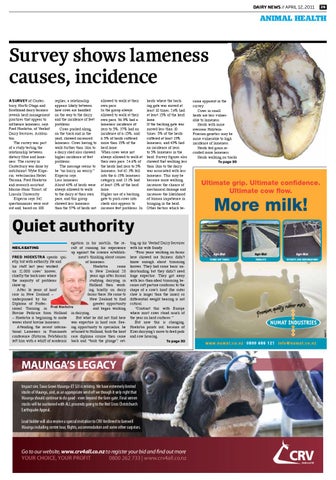Dairy News // april 12, 2011
29
animal health
Survey shows lameness causes, incidence A SURVEY of Canterbury, North Otago and Southland dairy farmers reveals herd management practices that appear to influence lameness, says Fred Hoekstra, of Veehof Dairy Services, Ashburton. The survey was part of a study testing the relationship between dietary fibre and lameness. The survey in Canterbury was done by nutritionist Wybe Kuperus, veterinarian Helwi Tacoma, Fred Hoekstra and research assistant Marius-Hans Troost, of Lincoln University. Kuperus says 342 questionnaires were sent out and, based on 108
replies, a relationship appears likely between how cows are handled on the way to the dairy and the incidence of feet problems. Cows pushed along, on the track and in the yard, showed increased lameness. Cows having to walk further than 1km to a dairy shed also showed higher incidence of feet problems. The message seems to be “no hurry, no worry,” Kuperus says. Less lameness About 43% of herds were always allowed to walk to the dairy at their own pace, and this group showed less lameness than the 57% of herds not
allowed to walk at their own pace. In the group always allowed to walk at their own pace, 56.5% had a lameness incidence of zero to 5%, 37% had an incidence of 6-15%, and 6.5% of herds suffered more than 15% of the herd lame. When cows were not always allowed to walk at their own pace. 24.6% of the herds had zero to 5% lameness, but 62.3% fell into the 6-15% lameness category, and 13.1% had at least 15% of the herd lame. Higher use of a backing gate to push cows into sheds also appears to increase feet problems. In
herds where the backing gate was moved at least 10 times, 24% had at least 15% of the herd lame. If the backing gate was moved less than 10 times. 5% of the herds suffered at least 15% lameness, and 43% had an incidence of zero to 5% lameness in the herd. Survey figures also showed that walking less than 1km to the dairy was associated with less lameness. This may be because more walking increases the chance of mechanical damage and increases the likelihood of human impatience in bringing in the herd. Other factors which be-
Quiet authority egotism in his nostrils, the result of running his experience up against the science establishFRED HOEKSTRA speaks quiment’s thinking about causes etly, but with authority. He and of lameness. his staff last year worked Hoekstra came on 12,000 cows’ hooves, to New Zealand 20 chiefly the back ones where years ago after formal the majority of problems studying dairying in show up. Holland then workAfter 16 years of hoof ing briefly on dairy care in New Zealand – farms there. He came to underpinned by his New Zealand to find Diploma of Profesgreater opportunity sional Training in Fred Hoekstra and began working Bovine Pedicure from Holland in dairying. – Hoekstra is beginning to make But what he did not find here waves about bovine lameness. was expertise in hoof care. SeeAttending the recent interna- ing opportunity to specialise, he tional Lameness in Ruminants returned to Holland, took the hoof conference (Rotorua, Feb/March) care diploma course then came left him with a whiff of academic back and “took the plunge”, setNEIL KEATING
ting up his Veehof Dairy Services with his wife Sandy. “Four years working on farms here showed me farmers didn’t know enough about trimming hooves. They had some basic understanding but they didn’t need huge expertise. They got away with less-than-ideal trimming because soft pasture conforms to the shape of a cow’s hoof (the outer claw is larger than the inner) so differential weight bearing is not critical. “Contrast this with Europe where most cows stand much of the year on hard surfaces.” But now this is changing, Hoekstra points out, because of Kiwi dairying’s move to feed pads and cow housing.
To page 30
MAUNGA’S LEGACY Impact sire, Tawa Grove Maunga-ET SJ3 is retiring. We have extremely limited stocks of Maunga, and, as an appropriate send off we though it only right that Maunga should continue to do good - even beyond the farm gate. Final semen stocks will be auctioned with ALL proceeds going to the Red Cross Christchurch Earthquake Appeal. Lead bidder will also receive a special invitation to CRV AmBreed to farewell Maunga including centre tour, flights, accommodation and some other surprises.
Go to our website, www.crv4all.co.nz to register your bid and find out more YOUR CHOICE, YOUR PROFIT 0800 262 733 | www.crv4all.co.nz
came apparent in the survey: Cows in small herds are less vulnerable to lameness. Herds with more overseas HolsteinFriesian genetics may be more vulnerable to high incidence of lameness. Herds fed grain recorded more lameness. Herds walking on tracks To page 30
